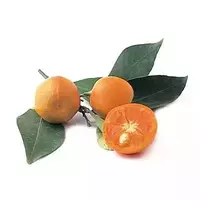Calamondine (cytrofortunella)

Citrus fruits are not limited only to the well-known lemon, tangerine, orange and grapefruit. This category is also represented by numerous, although not particularly popular exotic plants, among which kalamondin stands out. Interestingly, calamondin appeared as a result of the crossbreeding of kumquat (fortunella) and mandarin, in other words, it is a hybrid.
Calamondin or what this plant is otherwise called cytrofortunella is a member of the Rutov family. Its homeland is Southeast Asia. Calamondine (cytrofortunella) is a well-branching, fast-growing, small-sized evergreen tree. It features rather small glossy dark green leaves with an unusually pleasant smell. The white flowers of calamondin (cytrofortunella) also exude a very pleasant aroma.
The plant calamondin (cytrofortunella) is most often grown for ornamental purposes rather than fruit. However, it blooms profusely and bears fruit. The fruits of calamondin (cytrofortunella) are quite small - from
2. 5 to 4 centimeters in diameter, they resemble miniature tangerines. Fruiting, remarkably, does not stop throughout the year.
The fruits of calamondin (cytrofortunella) are quite edible - they have the same skin as the tangerine of bright orange color, but it is much thinner and sweeter. The fruit can hang on the branches of the plant for quite some time even after full ripening.
Despite the fact that the peel and the kalamondin fruit itself (cytrofortunella) smell unusually pleasant, the juicy flesh of the fruit is characterized by a bitter-acidic taste, due to which it is extremely rarely eaten in fresh whole form, such as, for example, the same orange or mandarin.
However, this representative of citrus fruits has one important advantage - the fruits of calamondin (cytrofortunella) can be used as food along with the skin, whose sweet taste compensates for the unattractive taste of the pulp. Most often, the use of calamondin (cytrofortunella) is to add small pieces of the fruit to tea - so it replaces lemon well.
Some hostesses prefer to make candied fruits from mature fruits, and also often add several lobes of calamondin (cytrofortunella) during the preparation of jam - so the finished product is distinguished by an unusual and at the same time rather pleasant citrus aroma and taste.
The useful properties of calamondin (cytrofortunella) are also known, which consist in an effective antiseptic effect, due to the content of a huge amount of vitamins C and P. However, the fully ripened fruits of calamondin (cytrofortunella) are not advised to keep on the branches for a long time, since from this they are made cotton and loose, losing their taste and juiciness.
calamondin (cytrofortunella) 53 kCal
Energy value of calamondin (cytrofortunella) (Ratio of proteins, fats, carbohydrates - ju):
Proteins: 0.81 g (~ 3 kCal)
Fats: 0.31 g (~ 3 kCal)
Carbohydrates: 11g (~ 44kCal)
Energy ratio (bj | y): 6% | 5% | 83%
 Español
Español Français
Français Português
Português Русский
Русский 简体中文
简体中文 繁體中文
繁體中文 日本語
日本語 한국어
한국어 العربية
العربية Türkçe
Türkçe Қазақ
Қазақ Deutsch
Deutsch Italiano
Italiano Українська
Українська
